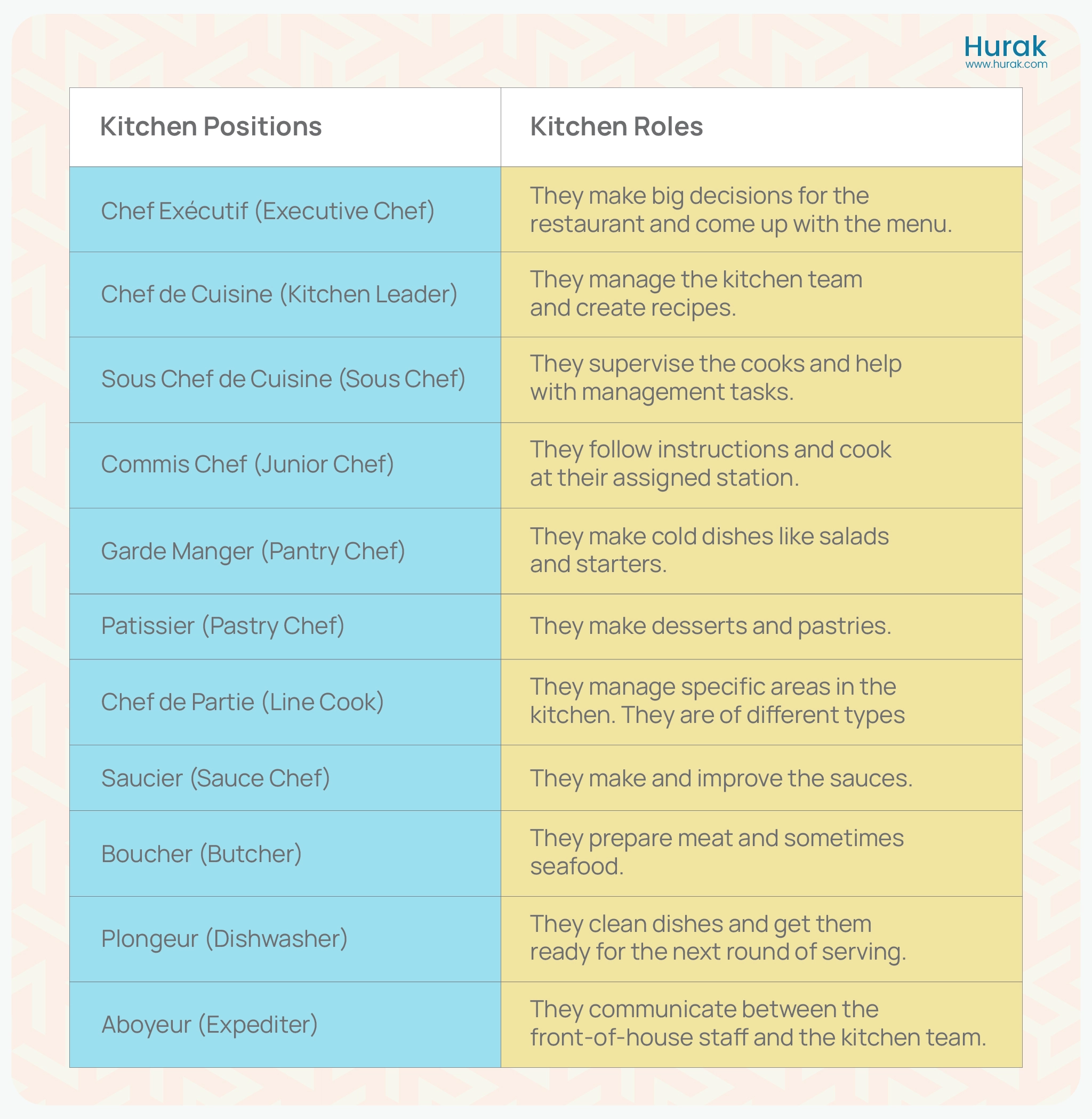There is a system called the Brigade de Cuisine in many professional kitchens today. It is a fancy French way of saying there is a specific order to how things are done in the kitchen.
What’s the Kitchen Brigade System?
The kitchen brigade system, or “brigade de cuisine”, organises the people who work in a restaurant kitchen so that everything runs smoothly. Each person has a specific job, which helps the kitchen work well.
In a big kitchen, there are many different jobs, like the boss chef (called the executive chef) and the assistant boss (sous chef). Other chefs (line cooks) look after different parts of the cooking.
For example, the chef in charge of making soups is the potager. Another one for seafood dishes is the poissonnier. For desserts, the chef is called the pâtissier.
The kitchen brigade idea started in fancy restaurants, but even fast-food places use a simpler version. In fast-food kitchens, there are stations for frying, grilling, and putting meals together. Cooks are hired to work at these stations and keep things running smoothly.

The Birth of the Kitchen Hierarchy
Georges Auguste Escoffier was a clever chef who devised a way to organise kitchen work like an army. In the 1800s, he used his experience from the French military to set up a system in hotel kitchens. The aim was to keep things running smoothly and avoid chaos.
Escoffier created a way to organise the kitchen staff. He gave each person a specific job to do. As time passed, kitchens got smaller, and wages went up. Escoffier’s system could still be adapted to fit any kitchen.
Get Online Food Safety Courses
Food Hygiene And Safety
Check the CourseRated Excellent
on major review sites

The ‘Mother’ Sauces
Escoffier also created five important sauces, the starting points for many others. These sauces are béchamel, velouté, espagnole, hollandaise, and tomato. They are handy in cooking, and each has special uses. Making them is easy, with simple ingredients like flour, butter, and some liquid.
Chef hierarchy in the kitchen
Just like an army has a general at the top, a restaurant kitchen has an executive chef as the big boss. According to the kitchen brigade system, the next in line is the chef de cuisine. Sometimes, a restaurant might have one or the other, not both. Right under the chef de cuisine is the sous chef (also known as the sous chef de cuisine).
Under the sous chef are the line cooks, also called chefs de partie. They are in charge of different parts of the kitchen, called stations. Some stations might have more than one chef. For instance, the pastry section might have a pastry chef, a baker, and someone who makes frozen desserts. The brigade is completed by junior chefs known as commis chefs.

The Kitchen Hierarchy Explained
The kitchen hierarchy, the Brigade de Cuisine, is like a team structure in a restaurant kitchen. Each team member has a particular job that helps the kitchen run smoothly.
Here are the leading kitchen position roles:
- Executive Chef: The big boss of the kitchen. They handle the management side and only sometimes cook directly.
- Chef de Cuisine (Head Chef): This is like the boss of cooking. They manage the whole kitchen, from staff to costs, and work closely with the restaurant manager and suppliers.
- Sous Chef (Deputy Chef): They help the head chef and often step in when needed. They’re hands-on with the cooking.
- Chef de Partie (Station Chef): These are the specialist cooks. Each one looks after a different kitchen part, making sure everything is cooked perfectly.
There are various types of station chefs.
- Sauce Chef: Makes sauces and gravies.
- Butcher Chef: Prepares meat and poultry.
- Fish Chef: Deals with fish and seafood.
- Roast Chef: Cooks roast meats.
- Fry Chef: Specialises in fried food.
- Grill Chef: The master of grilling.
- Pantry Chef: Prepares cold dishes like salads.
- Pastry Chef: Makes desserts and pastries.
- Roundsman: Fills in wherever needed.
- Commis Chef (Junior Chef): They learn from the station chefs and are usually still training.
- Kitchen Porter: They help with basic kitchen tasks and cleaning.
- Dishwasher: Washes all the dishes and equipment used in cooking.
- Waiter/Waitress: These folks work in the dining area, serving customers and letting the kitchen know if there are any issues with the food.
The following table summarises different kitchen positions and their roles.
Each role is important for keeping the kitchen running smoothly and ensuring customers get tasty food served just right.

Conclusion
In conclusion, the Brigade de Cuisine, or kitchen hierarchy, is like an organised team structure in restaurant kitchens. It confirms that every task is handled efficiently, just like an army operates. This system, introduced by Georges Auguste Escoffier, assigns specific roles to each kitchen staff member, from the top boss, the executive chef, down to the line cooks and junior chefs.
Even in fast-food kitchens, a simplified version of this system helps maintain order. Escoffier’s legacy extends beyond just organisation, he also introduced the ‘Mother’ sauces, which are important foundations for many dishes. Whether in a high-end restaurant or a fast-food joint, the kitchen brigade system allows everything to run smoothly, resulting in delicious meals served just right.




